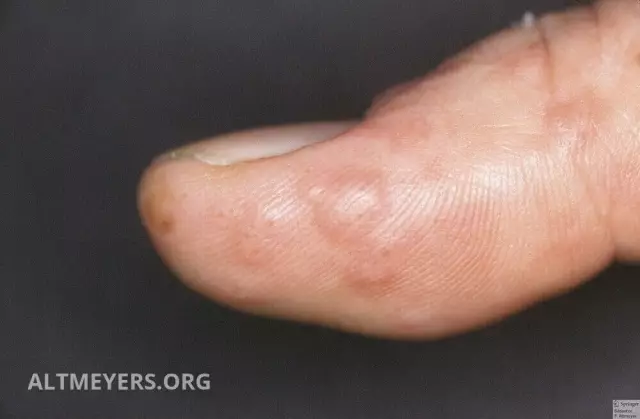- Author Rachel Wainwright [email protected].
- Public 2023-12-15 07:39.
- Last modified 2025-11-02 20:14.
Lymphostasis

Lymphostasis (lymphedema, lymphatic edema) is a congenital or acquired disease, persistent edema, which is accompanied by thickening of the skin, a noticeable thickening of the limbs, further leads to the formation of ulcers and the development of elephantiasis. Lymphostasis occurs due to an imbalance between the formation of lymph and its outflow from the capillaries and peripheral lymphatic vessels in the tissues of the limbs and organs, to the main lymphatic collectors and the thoracic duct.
Progressive lymphostasis destroys the lymphatic system, causing permanent psychological trauma in the patient, physical suffering and disability.
According to the WHO, young women (about 10% of the total population of the Earth) and elderly people most often get sick with lymphostasis.
Causes of lymphostasis
Depending on the causes of occurrence, lymphostasis is divided into primary and secondary. The cause of primary lymphostasis is considered to be a congenital anomaly of the lymphatic vessels. Sometimes the disease can be detected immediately after birth, but, more often, the disease manifests itself and is detected in the first half of life, during puberty.
The cause of secondary lymphostasis can be phenomena of the following order:
- The appearance of benign and malignant tumors of the lymphatic system
- Various injuries (mechanical damage, burns, radiation exposure, etc.) that damage lymphatic vessels and lymph nodes
- Patient's sedentary lifestyle (mainly in bedridden patients)
- Chronic diseases leading to venous insufficiency and lymphostasis of the extremities, complicated by post-thrombophlebitic disease, most often in the elderly
- Staphylococcal and parasitic infections
Also, the causes of secondary lymphostasis can be:
- Erysipelas of the lower extremities
- Obesity
- Klippel-Trenone syndrome
- Operations on the chest cavity for oncology
Stages and symptoms of lymphostasis
There are 3 stages of lymphostasis development:
At the first stage, there is a slight reversible edema that appears in the evening and disappears in the morning after sleep. Over time, the edema becomes systematic and, although patients at this stage rarely go to the doctor, the emerging anxiety forces them to use folk remedies and self-medicate (bandage swollen limbs, draw an iodine net, apply compresses). At this stage, connective tissue growths have not yet begun, and with timely access to a doctor and adequate treatment, the disease recedes
At the 2nd stage, the symptoms of lymphostasis increase and are characterized by irreversible edema, the growth of connective tissues and hardening of the skin occur. Tightness of the skin can cause pain in the patient. When pressed on the tissue for a long period, a pit remains. At this stage, patients most often go to the doctor. Despite the complexity of treatment, if the patient makes the necessary efforts and follows the doctor's recommendations, recovery is possible
At stage 3, the symptoms of lymphostasis increase and the disease becomes irreversible. Fibrosis, cysts appear, pronounced lymphostasis of the extremities is manifested, their contour is lost, functions are disturbed, the stage of elephantiasis and limitation of mobility begins. If untreated, trophic ulcers, erysipelas, eczema occur
The problems are getting worse, and can lead to many serious complications, including sepsis and death.
Diagnosis of lymphostasis
- Diagnostics of lymphostasis consists in carrying out the following examinations:
- clinical and biochemical analysis of blood and urine
- consultation of a vascular surgeon with examination of the chest cavity and ultrasound of the abdominal cavity, small pelvis and veins of the lower extremities (with limb lymphostasis)
- lymphography of lymphatic vessels to clarify their patency
If necessary, consultations of other specialists are prescribed for the diagnosis of lymphostasis.
Lymphostasis treatment

Regardless of the stage of the disease and the symptoms of lymphostasis, all patients are subject to dispensary observation by an angiosurgeon. The purpose of the treatment is to normalize the outflow of lymph from the lower extremities and other organs.
Lymphostasis treatment is a long and complicated process. Applied hardware techniques (pneumomassage, magnetotherapy, laser therapy) in combination with complex conservative methods (manual lymphatic drainage, the imposition of a compression bandage).
From medicines, polyvalent venotonics with a lymphotropic effect are prescribed, to improve peripheral circulation - angioprotectors, prostaglandins, antibiotic therapy, immunostimulating, diuretic and desensitizing therapy.
In the treatment of lymphostasis, great importance is attached to adherence to a subcaloric diet with restriction of sodium chloride, physiotherapy exercises and general activation: jogging, swimming, etc. Also important is the patient's mood, his dedication to recovery, the implementation of medical recommendations.
Treatment of lymphostasis with folk remedies
Treatment of lymphostasis with folk remedies consists in cleansing the body with enemas according to various methods, using apple cider vinegar, dandelion juice, plantain, a mixture of red grape wine and fresh red beetroot juice, aqueous horseradish tincture or aspen bark. Decoctions of oregano, knotweed, fir branches, leaves and flowers of ivan tea are also used in the treatment of lymphostasis with folk remedies.
YouTube video related to the article:
The information is generalized and provided for informational purposes only. At the first sign of illness, see your doctor. Self-medication is hazardous to health!






